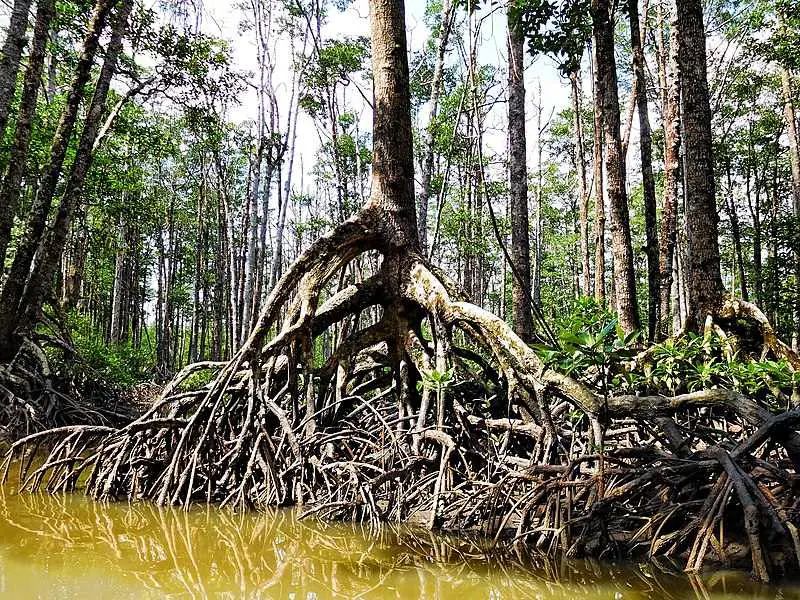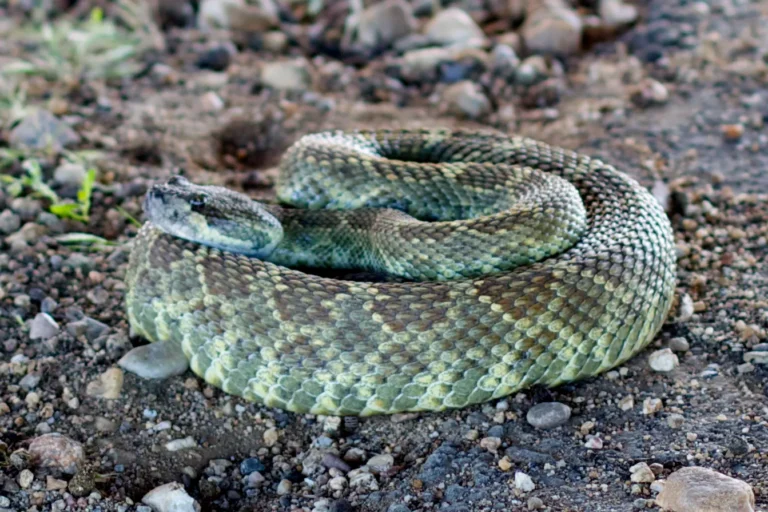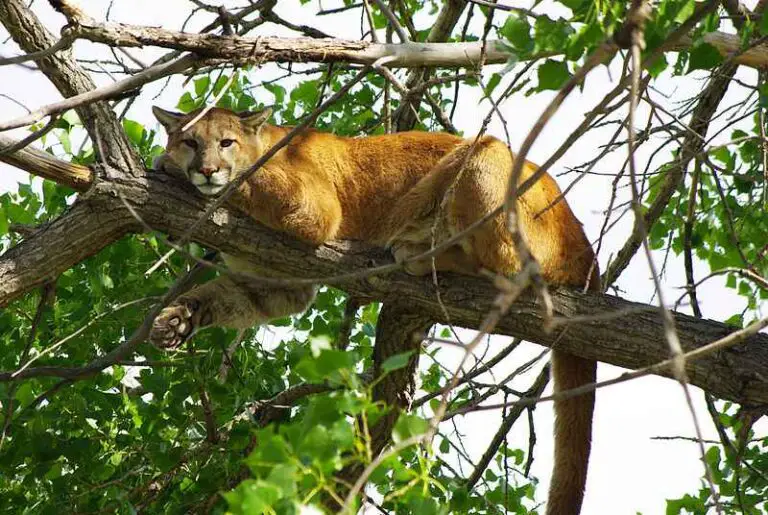5 Abiotic Factors in Mangroves and Their Attributes Discussed
Abiotic factors in mangroves are; water, soil (and nutrients), atmospheric gases, solar radiation, and physicochemical parameters.
They cover the inorganic components, conditions and processes of not only mangroves, nut adjacent wetlands, coasts and marine ecosystems.
1). Mangrove Water (as one of the Abiotic Factors in Mangroves)
Water is a very important abiotic factor in mangroves, because of its relatively-large quantity and multiple roles in the ecosystem.
In fact, water is one of the most critical mangrove-abiotic factors, as it influences the adaptation of plants and animals, as well as processes that determine the sustainability of both abiotic and biotic components of a mangrove ecosystem.
Mangroves typically occur in intertidal zones that separate marine water bodies from terrestrial and freshwater-aquatic ecosystems [5].
Here, they are subject to continuous tidal fluctuations that lead to mixing of saltwater and freshwater resources, so that it is correct to describe mangrove water as being brackish, in many cases.
Flooding, soil-inundation and waterlogged conditions are fairly common in mangroves, and these have resulted in the development of adaptive specializations in plant roots.
Mangrove plants have roots that are physiologically equipped to provide anchorage in soft muddy-sediments, and to access sufficient amount of oxygen while being submerged under saltwater in high-tide periods.
Organelles and root systems for such underwater breathing have been described as pneumatophores, and are one of the distinctive features evolved under the constraints created by water, in mangroves [1].
Mangrove ecosystems get water from three main sources that include; tidal influx, groundwater upwelling, and precipitation.
The activities of mangrove organisms in their humid, water-saturated environment are relevant to the natural recycling of hydrological resources within mangrove zones. These activities include water storage, salt excretion, and transpiration.
Lastly, the influx of water into mangrove forests and swamps contributes to their species richness, biodiversity and unique physicochemical conditions, and allows the mangrove to exhibit some characteristics typical of both aquatic and terrestrial ecosystems.

2). Mangrove Soil
Because mangrove soil is saturated with saline water for long periods every year, it has distinctive characteristics that make it essential as an abiotic factor.
To begin with, the water-saturation of pore-spaces in mangrove soil makes it oxygen-deficient, or anoxic, especially in comparison to soils in core terrestrial biomes like grasslands.
These anoxic conditions support the growth of anaerobic microorganisms in mangrove soil, and their anaerobic digestion/biodegradation of organic matter in the absence of sufficient oxygen generates hydrogen sulfide that is known for its foul odor and toxicity [4].
Saline-water saturation also implies that mangrove soils contain significant amount of salt in solution. The salinity of soil in any given mangrove ecosystem varies with geographic, hydrological and edaphic factors, and forces organisms to become saltwater-tolerant or die-off.
The condition of soil in mangroves is relatively stable, with relatively-low rates of erosion and sediment deposition, and minor pH fluctuations driven by tidal and groundwater-saline intrusions.
pH affects mangrove plants and animals adversely, such that their chances of survival and thriving are directly influenced by the pH conditions of their environment. Lower pH values indicate higher acidity, and lower organic survival rates. This analogy further reveals the importance of mangrove soil salinity, which is linked to pH.
Mangrove plants survive while growing in anoxic soil because of their specialized root system and tissue-respiration mechanism.
Also, mangrove soils are rich in organic matter or biomass, because the anoxic and saline conditions prevent plant and animal remains and waste from decomposing rapidly [2]. In fact, slow decomposition makes the mangrove an ideal site for the generation of fossil fuel-energy resources like coal and petroleum.
Mangrove soils are instrumental in carbon and oxygen cycles, as well as other systems of natural nutrient conservation in their environment. Most nutrients (which constitute a secondary abiotic factor) in mangroves are conserved in the soil through processes like carbon sequestration and nitrogen fixation.
In fact, the efficiency of the soil with respect to conserving and recycling nutrients, explains why mangrove swamps are effective as natural carbon sinks.
Tides, organic activities and climatic conditions all dictate the dynamics of nutrients in the mangrove. Some examples of mangrove nutrients are; phosphorus (P), nitrogen (N), calcium (Ca) and potassium (K).
3). Atmospheric Gases (as one of the Abiotic Factors in Mangroves)
Conditions of the atmosphere affect mangroves by influencing physicochemical parameters, nutrient supply, and the availability of essential gases like oxygen and carbon dioxide that mangrove organisms need for their metabolism.
Atmospheric gases in the mangrove include methane, oxygen, and carbon dioxide, as well as nitrogen and trace gases.
Methane (CH4) is a carbonaceous greenhouse gas that is generated as a byproduct of organic activities in mangrove soil [3]. The rate at which methane is emitted from any given mangrove soil depends on salinity, microbial activity and temperature, among other factors.
Oxygen (O2) is important for its role in respiration of mangrove animals, and plant-roots. It is produced mainly as a byproduct, of the photosynthetic conversion of carbon dioxide, sunlight and water to bioenergy and biomass.
Carbon dioxide (CO2) is useful in mangrove-plant photosynthesis. Large quantities of carbon dioxide are stored away from the atmosphere in the form of organic carbon in mangrove soils.
Atmospheric gases are collectively called air; and may affect growth patterns, adaptations, wind dynamics, and temperature of mangrove ecosystems.
4). Solar Radiation
Solar radiation refers to electromagnetic waves from the Sun, that comprise of thermal energy and visible light.
In mangrove ecosystems, solar radiation is essential toward growth, survival, and sustainability.
Sunlight supplies energy that is used in photosynthesis, which is the main process that introduces energy into the food chain and energy pyramid of the mangrove ecosystem.
The amount of sunlight that is available to mangroves determine the productivity of plants, and the vegetative structure of the ecosystem. Mangroves with surplus supply of solar radiation tend to have denser growth of both vascular and non-vascular plants, that may form canopies almost similar to those in tropical rainforests.
By supplying energy for photosynthesis, solar radiation determines the amount of oxygen that is available to mangrove organisms, and thereby influences biodiversity.
Thermal energy from solar radiation also influences the mangrove in areas such as salinity, pH, organic adaptation and survival, as well as the rate of decomposition and nutrient-cycling.

5). Physicochemical Parameters (as one of the Abiotic Factors in Mangroves)
As the name implies, physicochemical parameters in the mangrove ecosystem are factors that determine the physical and chemical conditions of mangrove soil, water and atmospheric gases.
Physicochemical parameters work alongside other biotic factors to influence the functionality and structure of mangroves.
Examples of physicochemical parameters in mangroves are salinity, pH, humidity, soil moisture-content, light penetration, and temperature.
The abiotic factor which limits plant growth the most, in mangroves, is salinity. This is because plant roots are in contact with saline water for significant periods each year, and excessively-high salt concentration can destroy these roots through osmotic cell-damage, thereby reducing the plants' chances of survival.
Extreme physicochemical conditions like excessively-high or low temperature, generally have a negative impact on mangrove organisms.
Conclusion
Abiotic factors in mangroves are;
1. Mangrove Water
2. Mangrove Soil
3. Atmospheric Gases
4. Solar Radiation
5. Physicochemical Parameters
References
1). Dahdouh-Guebas, F.; Kairo, J..G.; De Bondt, R.; Koedam, N. (2007). "Pneumatophore height and density in relation to micro-topography in the grey mangrove Avicennia marina." Belgian Journal of Botany 140(2):213-221. Available at: https://doi.org/10.2307/20794640. (Accessed 28 May 2023).
2). Kida, M.; Fujitake, N. (2020). "Organic Carbon Stabilization Mechanisms in Mangrove Soils: A Review." Forests 11(9):981. Available at: https://doi.org/10.3390/f11090981. (Accessed 28 May 2023).
3). Kumar, G.; Ramanathan, A. (2014). "Biogeochemistry of methane emission in mangrove ecosystem - Review." Indian Journal of Geo-Marine Sciences 43(6):989-997. Available at: https://www.researchgate.net/publication/279331773_Biogeochemistry_of_methane_emission_in_mangrove_ecosystem_-_Review. (Accessed 28 May 2023).
4). Martin, K. E.; Currie, S. (2020). "Hydrogen sulphide sensitivity and tolerance in genetically distinct lineages of a selfing mangrove fish (Kryptolebias marmoratus)." Springer, Journal of Comparative Physiology B 190(1). Available at: https://doi.org/10.1007/s00360-020-01302-4. (Accessed 28 May 2023).
5). Nagelkerken, I.; Blaber, S. J. M.; Bouillon, S.; Green, P.; Haywood, M. D. E.; Kirton, L. G.; Meynecke, J.-O.; Pawlik, J. R.; Penrose, H.; Sasekumar, A.; Somerfield, P. (2008). "The habitat function of mangroves for terrestrial and marine fauna: A review." Aquatic Botany 89(2). Available at: https://doi.org/10.1016/j.aquabot.2007.12.007. (Accessed 28 May 2023).





